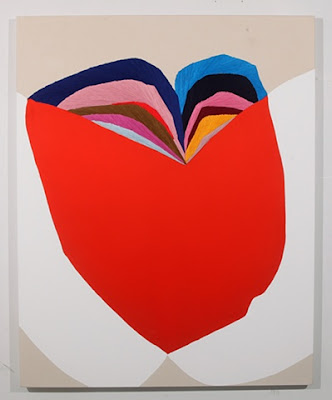Amanda Valdez
Recently acquiring her MFA at Hunter College,
Amanda Valdez is an artist based in New York City. Valdez is primarily an abstract painter who employs fabric, sewing, and yarn in her process, along with occasional silkscreening.
 |
Untitled (Temple One), 2010.
Fabric and Canvas
12" x 12" |
Grid Paintings
Grid paintings come a dime a dozen, but Valdez's grids use a process that is unparalleled. Sewing fabric to canvas, the forms created by the fabric are literally integral in the object itself, rather then buying a ready-made canvas. This also exposes the objecthood, the
reality of paint, as well as the
object-hood of the canvas itself, rather than denying this element and rendering what is purely an
image. This object/image dialogue is reoccurring throughout Valdez's paintings.
The painting
Untitled (Temple One), is divided into five larger horizontal strips of canvas that are subdivided into messy rhomboids of disparate fabrics. The lattice, which is made up by sewn stitches is an organic, quivering line which is clearly intentional. These irregular lines, in addition to the alternation of light and dark colors give the viewer a sense of depth and three-dimensionality in. However, some cells resist that by bringing the viewer back to the surface of the image. The quivering line lattice and the balance of depth and flatness in this grid, as well as the few color anomalies seem to make the painting as a whole not necessarily read as a grid, but an image of stacked objects with a sense of gravity (which seems intentional considering the title).
 |
Dwells Among Us, 2011.
Embroidery, Fabric, Gesso, and Canvas
48" x 36" |
Abstract Paintings
Amanda Valdez's painting Dwells Among Us. The forms seem to walk on the edge of color-field paintings and geometric abstraction. As you can see in the detail (below), the two arcs in the upper portion of the canvas consist of multi-colored strands of yarn which are heavily affected by lighting when the viewer navigates around it. This element as well as adding literal depth to canvas, creates a figure-ground play in which the yarn form and the organic red form seem to constantly remain in flux. This is no small task considering the brilliance of the red form.
Just as with her grid paintings, the abstract forms of her other paintings remain on the edge of abstraction and representation. The push and pull between bother pictorial depth and literal depth allow the viewer to switch between reading the paintings as objective and non-objective abstraction. However, after reading her studio blog:
and there will be trouble, you will find that it more than likely is objective abstraction. For your viewing pleasure I will leave you with this gift:
Amanda Valdez's personal website
 |
Dwells Among Us, 2011.
Detail |










